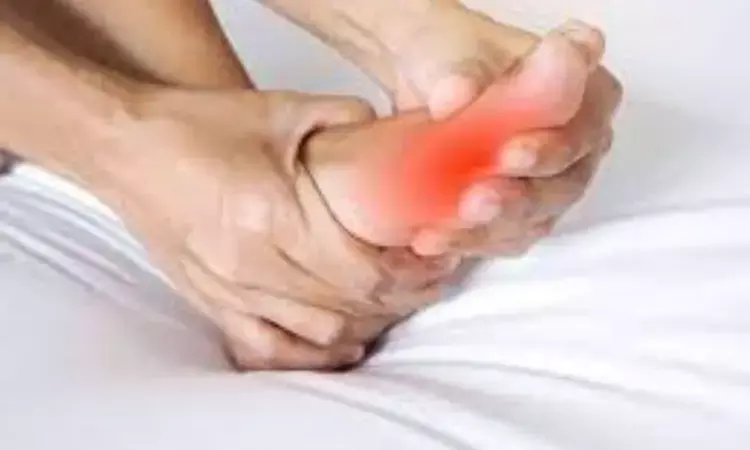- Home
- Medical news & Guidelines
- Anesthesiology
- Cardiology and CTVS
- Critical Care
- Dentistry
- Dermatology
- Diabetes and Endocrinology
- ENT
- Gastroenterology
- Medicine
- Nephrology
- Neurology
- Obstretics-Gynaecology
- Oncology
- Ophthalmology
- Orthopaedics
- Pediatrics-Neonatology
- Psychiatry
- Pulmonology
- Radiology
- Surgery
- Urology
- Laboratory Medicine
- Diet
- Nursing
- Paramedical
- Physiotherapy
- Health news
- Fact Check
- Bone Health Fact Check
- Brain Health Fact Check
- Cancer Related Fact Check
- Child Care Fact Check
- Dental and oral health fact check
- Diabetes and metabolic health fact check
- Diet and Nutrition Fact Check
- Eye and ENT Care Fact Check
- Fitness fact check
- Gut health fact check
- Heart health fact check
- Kidney health fact check
- Medical education fact check
- Men's health fact check
- Respiratory fact check
- Skin and hair care fact check
- Vaccine and Immunization fact check
- Women's health fact check
- AYUSH
- State News
- Andaman and Nicobar Islands
- Andhra Pradesh
- Arunachal Pradesh
- Assam
- Bihar
- Chandigarh
- Chattisgarh
- Dadra and Nagar Haveli
- Daman and Diu
- Delhi
- Goa
- Gujarat
- Haryana
- Himachal Pradesh
- Jammu & Kashmir
- Jharkhand
- Karnataka
- Kerala
- Ladakh
- Lakshadweep
- Madhya Pradesh
- Maharashtra
- Manipur
- Meghalaya
- Mizoram
- Nagaland
- Odisha
- Puducherry
- Punjab
- Rajasthan
- Sikkim
- Tamil Nadu
- Telangana
- Tripura
- Uttar Pradesh
- Uttrakhand
- West Bengal
- Medical Education
- Industry
Among gout patients, Flare Risk similar during initiation and titration of Allopurinol and Febuxostat: Study

Researchers in a recent study have found that the risk of gout flares is similar during the initiation and titration of allopurinol and febuxostat when administered as part of a treat-to-target strategy with optimal anti-inflammatory prophylaxis. The study was published in the journal Arthritis & Rheumatology.
Initiation of urate-lowering therapy in patients with gout often provokes gout flares. The degree of serum urate reduction can contribute to these attacks; the greater, the increased flare risk. Allopurinol and febuxostat represent two of the common medications used for ULT in the management of gout, and which one of these is better in reducing flare risk is uncertain.
The researchers, led by Dr. Austin Barry from the Veterans Affairs Nebraska-Western Iowa Health Care System and the University of Nebraska Medical Center, investigated whether flare risk during allopurinol initiation and titration could be compared directly with flare risk during febuxostat initiation and titration. As a background to their study, the authors performed a post-hoc analysis of the STOP-Gout trial to see which of the two agents was more efficient in reducing flare risk when such an approach was used as a treat-to-target strategy.
The STOP Gout trial was a 72-week randomized, double-blind, placebo-controlled, non-inferiority study comparing the efficacy of allopurinol and febuxostat in 940 gout patients undergoing anti-inflammatory prophylaxis. Of these, half of the participants were randomized to either of the two medication arms.
The study group assessed gout flares during the first 24 weeks of ULT, titrating the therapy with a goal serum urate less than 6 mg/dL or less than 5 mg/dL in those participants with tophi. Structured interview-based flare assessments were performed at regular intervals. Modeling of predictors of flares used multivariable Cox proportional hazards regression.
Key findings from the study include:
• One flare at a minimum was seen in 42.1% of participants receiving allopurinol and 46.2% receiving febuxostat during the first 24 weeks.
• The mean change in urate levels was similar between those subjects who did versus did not have a flare (3.24 ± 1.87 mg/dl vs 3.12 ± 1.68 mg/dl, respectively; P = 0.34).
• In multivariable analysis, no differences in flare risk were noted between febuxostat and allopurinol: aHR, 1.17; 95% CI, 0.90 to 1.53.
• There was no difference in flare risk with an increased dose of ULT compared with no increase in dose aHR 1.18, 95% CI 0.86–1.63.
• Participants with ir individuals with tophi had a 30% decreased risk of flare.
Other independent factors linked to flare risk included younger age (HR, 0.86; 95% CI, 0.78 – 0.98 per 10 years) and higher baseline serum urate levels (aHR, 1.09; 95% CI, 1.01 – 1.18 per mg/dl). The presence of stage 3 chronic kidney disease and baseline C-reactive protein levels were associated with a greater flare risk, but these did not reach statistical significance.
Allopurinol and febuxostat do not differ in terms of gout flares risk when a treat-to-target strategy is initiated and titrated with optimal anti-inflammatory prophylaxis. From these data, clinicians may use either drug to treat patients with gout with confidence, using individual patient factors to minimize flare risk.
Reference:
Barry A, Helget LN, Androsenko M, et al. A Comparison of Gout Flares with the Initiation of Treat-to-Target Allopurinol and Febuxostat: A Post-hoc Analysis of a Randomized Multicenter Trial. Arthritis Rheumatol. Published online June 24, 2024. doi:10.1002/art.42927
Dr Riya Dave has completed dentistry from Gujarat University in 2022. She is a dentist and accomplished medical and scientific writer known for her commitment to bridging the gap between clinical expertise and accessible healthcare information. She has been actively involved in writing blogs related to health and wellness.
Dr Kamal Kant Kohli-MBBS, DTCD- a chest specialist with more than 30 years of practice and a flair for writing clinical articles, Dr Kamal Kant Kohli joined Medical Dialogues as a Chief Editor of Medical News. Besides writing articles, as an editor, he proofreads and verifies all the medical content published on Medical Dialogues including those coming from journals, studies,medical conferences,guidelines etc. Email: drkohli@medicaldialogues.in. Contact no. 011-43720751


